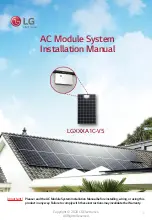
Electronics
AC Module System Installation Manual
Copyright © 2020 LG Electronics.
All Rights Reserved.
8
Rev. 1.0
• Use proper equipment, connectors, wires and buttresses for the installation of the module.
• To reduce the risk of accidents, install the AC modules during mild weather. For rainy or snowy days,
electric shock hazard exists. On windy days, it may be dangerous to move the AC modules.
• To prevent the risk of injury, do not apply pressure to the module (ex. placing heavy objects or stepping
on the module).
• To prevent the risk of injury, do not drop the module. Modules must be gently handled and placed down
with care.
• For proper operation, do not scratch the coating surface of the frame. It may increase the corrosion of
the frame.
•
For proper operation, do not artificially concentrate sunlight on the module surface.
• Addition of holes in the frame or glass of the module may decrease the strength and integrity of the
frame or glass.
• Do not remove warning labels. Do not apply a shock to microinverter of the module or pull the AC cable.
Do not remove the labels attached on the module except the detachable label for installation map.
• Store the module in its original package until installation.
• Do not use any kind of oil or lubricant on the module’s parts, as it can damage the AC Module.
•
AC modules shall be mounted with racking and mounting products certified and listed for system fire
class rating in accordance with UL1703 edition 2014 and UL2703 edition 2014.
• The System Fire Class Rating of the module or panel in a mounting system in combination with a roof
covering must meet the requirements to achieve the specified System Fire Class Rating for a non-BIPV
module or panel.
• For better air circulation along the backside of the AC module, it is recommended to install the PV
rack with a gap of at least 4 inches (100mm) between the back of the module and roof surface. It may
affect UL listing and fire class if it is less than 4 inches (100mm).
• Please check voltage range for use before installation of AC modules and EnerBox2. Refer to Section
9
Product Specifications.
•
When installed on a roof, the PV module must be mounted over a fire-resistant roof. The fire resistance
of the PV module is class C according to ANSI/UL790.
•
It is recommended to check with local authorities for fire safety guidelines and requirements for any
buildings or structures on to which the panels will be installed.
• Both AC and DC voltage sources are terminated inside this equipment.
• Each circuit must be individually disconnected before servicing.
• When the photovoltaic array is exposed to light, it supplies a DC voltage to this equipment.
• AC module arrays need to be connected only to a dedicated branch circuit.









































